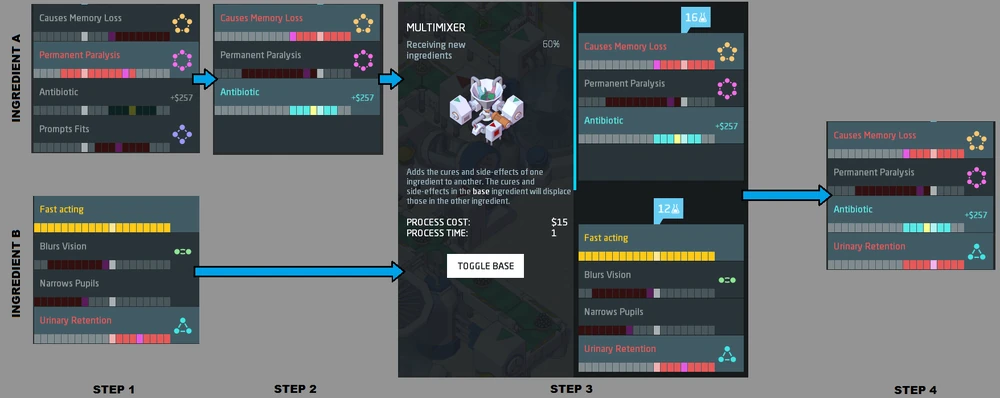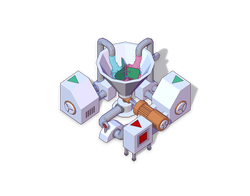Scifiwriterguy (talk | contribs) (Incremental save) Tag: Visual edit |
Scifiwriterguy (talk | contribs) (Major edit finished. Process for using the multimixer added (along with diagram) after a lengthy Steam community discussion surrounding confusion with the mixer. Should help folks with the same question!) Tag: Visual edit |
||
| Line 10: | Line 10: | ||
==Function== |
==Function== |
||
| − | Despite being an important machine, the Multimixer is prone to causing confusion. Errors made when loading or configuring the mixer result in undesired output, and the cause may not be readily apparent. |
+ | Despite being an important machine, the Multimixer is prone to causing confusion. Errors made when loading or configuring the mixer result in undesired output, and the cause may not be readily apparent. |
== Process == |
== Process == |
||
| − | Despite being an important machine, the Multimixer is prone to causing confusion. Errors made when loading or configuring the mixer result in undesired output, and the cause may not be readily apparent. |
+ | Despite being an important machine, the Multimixer is prone to causing confusion. Errors made when loading or configuring the mixer result in undesired output, and the cause may not be readily apparent. The example below explains the mixing process for transferring a single effect, although the Multimixer can transfer more than one effect at a time. |
| − | [[File:Multimixer Process.png|left|thumb| |
+ | [[File:Multimixer Process.png|left|thumb|1000x1000px|Multimixer process diagram. ]] |
=== Step 1 === |
=== Step 1 === |
||
| Line 22: | Line 22: | ||
Following the process to eliminate a removable side effect, the Prompts Fits side effect is removed from Ingredient A, freeing up Slot 4. The desired effect in Ingredient B is in Slot 4, so no changes need to be made to it. |
Following the process to eliminate a removable side effect, the Prompts Fits side effect is removed from Ingredient A, freeing up Slot 4. The desired effect in Ingredient B is in Slot 4, so no changes need to be made to it. |
||
| − | Had the desired effect in Ingredient B been in a different slot, such as Slot 2, Ingredient B would need to go through a Shaker to sift it down into Slot 4. (EIther through two basic Shakers or one upgraded Shaker set to a 2 space shift. See the Shaker article for details.) |
+ | Had the desired effect in Ingredient B been in a different slot, such as Slot 2, Ingredient B would need to go through a Shaker to sift it down into Slot 4. (EIther through two basic Shakers or one upgraded Shaker set to a 2 space shift. See the Shaker article for details.) Furthermore, if more than one effect were being transferred from B to A, a second side effect would need to be removed from Ingredient A and <u>both</u> blank spaces would need to be aligned with the desired effects being mixed in from Ingredient B. |
=== Step 3 === |
=== Step 3 === |
||
Both ingredients go into the Multimixer. Note that one ingredient - in this case, Ingredient A - is marked with a blue line down its left side in the Multimixer control panel. The blue line indicates which drug is set as the ''base drug''. This is the drug that will receive effects from the non-base drug. If the blue line is <u>not</u> next to the drug that is supposed to receive the effect, the ''Toggle Base'' button can be used to change the base drug setting. |
Both ingredients go into the Multimixer. Note that one ingredient - in this case, Ingredient A - is marked with a blue line down its left side in the Multimixer control panel. The blue line indicates which drug is set as the ''base drug''. This is the drug that will receive effects from the non-base drug. If the blue line is <u>not</u> next to the drug that is supposed to receive the effect, the ''Toggle Base'' button can be used to change the base drug setting. |
||
| − | The Urinary Retention/Catalyst effect in Slot 4 of Ingredient B is shifted into the blank Slot 4 in Ingredient A (since Ingredient A is set as the base drug. |
+ | The Urinary Retention/Catalyst effect in Slot 4 of Ingredient B is shifted into the blank Slot 4 in Ingredient A (since Ingredient A is set as the base drug. The other effects in the non-base drug (in this case, Ingredient B) are lost during the mixing process and cannot be recovered or used. |
| + | |||
| + | === Step 4 === |
||
| + | The combined result is ejected through the output port once a belt is connected. |
||
| + | |||
| + | == Alternatives == |
||
| + | Two other machines can be used for transferring effects into a drug. |
||
| + | |||
| + | === [[Centrifuge]] === |
||
| + | While similar to the Multimixer in principle, the process is significantly different. Instead of moving an effect into a blank space, the centrifuge can be used to swap ingredients (half in the base machine, specific slots when upgraded). Furthermore, no effects are discarded; both drugs are output at the end of the process. See the [[centrifuge]] article for an explanation. |
||
| + | |||
| + | === [[Booster Mixer]] === |
||
| + | When only adding a booster to a drug, the Booster Mixer is an easier option than the Multimixer or Centrifuge. Any boosters present in the booster drug replace any existing effects in the base drug already in the slot(s) where the booster(s) are present. See the [[Booster Mixer|booster mixer]] article for an explanation. |
||
==Upgrades== |
==Upgrades== |
||
Revision as of 03:02, 4 February 2017
The Multimixer is one of the Machines in Big Pharma, and it is needed for adding catalysts to drugs to enable the production of higher-level cures.
Description
The Multimixer combines 2 drugs together into a single drug.
Function
Despite being an important machine, the Multimixer is prone to causing confusion. Errors made when loading or configuring the mixer result in undesired output, and the cause may not be readily apparent.
Process
Despite being an important machine, the Multimixer is prone to causing confusion. Errors made when loading or configuring the mixer result in undesired output, and the cause may not be readily apparent. The example below explains the mixing process for transferring a single effect, although the Multimixer can transfer more than one effect at a time.

Multimixer process diagram.
Step 1
In this example, Ingredient A is the base drug into which the Type 3 catalyst from Ingredient B (Urinary Retention side effect) must be added. However, Ingredient A has no free spaces; all four effects are populated. Ergo, a side effect needs to be removed.
Step 2
Following the process to eliminate a removable side effect, the Prompts Fits side effect is removed from Ingredient A, freeing up Slot 4. The desired effect in Ingredient B is in Slot 4, so no changes need to be made to it.
Had the desired effect in Ingredient B been in a different slot, such as Slot 2, Ingredient B would need to go through a Shaker to sift it down into Slot 4. (EIther through two basic Shakers or one upgraded Shaker set to a 2 space shift. See the Shaker article for details.) Furthermore, if more than one effect were being transferred from B to A, a second side effect would need to be removed from Ingredient A and both blank spaces would need to be aligned with the desired effects being mixed in from Ingredient B.
Step 3
Both ingredients go into the Multimixer. Note that one ingredient - in this case, Ingredient A - is marked with a blue line down its left side in the Multimixer control panel. The blue line indicates which drug is set as the base drug. This is the drug that will receive effects from the non-base drug. If the blue line is not next to the drug that is supposed to receive the effect, the Toggle Base button can be used to change the base drug setting.
The Urinary Retention/Catalyst effect in Slot 4 of Ingredient B is shifted into the blank Slot 4 in Ingredient A (since Ingredient A is set as the base drug. The other effects in the non-base drug (in this case, Ingredient B) are lost during the mixing process and cannot be recovered or used.
Step 4
The combined result is ejected through the output port once a belt is connected.
Alternatives
Two other machines can be used for transferring effects into a drug.
Centrifuge
While similar to the Multimixer in principle, the process is significantly different. Instead of moving an effect into a blank space, the centrifuge can be used to swap ingredients (half in the base machine, specific slots when upgraded). Furthermore, no effects are discarded; both drugs are output at the end of the process. See the centrifuge article for an explanation.
Booster Mixer
When only adding a booster to a drug, the Booster Mixer is an easier option than the Multimixer or Centrifuge. Any boosters present in the booster drug replace any existing effects in the base drug already in the slot(s) where the booster(s) are present. See the booster mixer article for an explanation.
Upgrades
| Unlock: |
|---|
| Yields: |
| CLICK TO UPGRADE: |
|---|
 x 1 x 1 |
| $30 |
| CLICK TO UPGRADE: |
|---|
 x 2 x 2 |
| $27 |
| CLICK TO UPGRADE: |
|---|
 x 4 x 4 |
| $24 |
| CLICK TO UPGRADE: |
|---|
 x 8 x 8 |
| $21 |
| CLICK TO UPGRADE: |
|---|
 x 16 x 16 |
| $18 |
| Machines | |
| Belts | Belt |
|---|---|
| Basic | Evaporator • Dissolver • Agglomerator • Ioniser • Autoclave • Cryogenic Condenser |
| Advanced | Chromatograph • Ultraviolet Curer • Sequencer • Hadron Collider |
| Auxiliary | Analyser • Multimixer • Shaker • Centrifuge • Packer • Booster Mixer • Stock Gate |
| Makers | Pill Printer • Creamer • Sachet Fabricator • Syringe Injector |

